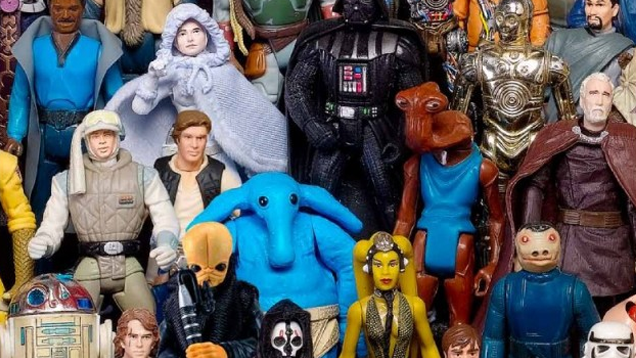
When Star Wars released in 1977, the face of science fiction in popular culture was changed forever — but a year later, the movie helped transform the toy industry as well. Since then, Star Wars and the toys it inspired have been forever linked, a story that can just as easily be told through figures as it can the films.
Top image from the cover of Stephen J. Sansweet’s Star Wars: The Ultimate Action Figure Collection.
An Unexpected Alliance
When George Lucas and 20th Century Fox were trying to market Star Wars, they planned for something almost entirely unprecedented at the time — a marketing deluge, and a full scale licensing project that would see t-shirts, posters, lunchboxes and yes, toys, covered in the movie’s characters, hit shelves. In a move that, in hindsight, was incredibly shrewd, Lucas negotiated with Fox to take the bulk of revenue from merchandise sales, with neither side believing that the movie’s tepid response before release could lead to much in terms of profit.
The lukewarm reaction spread to licensees too. Lucasfilm and Fox first offered the Mego Corporation — whose 8” licensed dolls of DC superheroes, Star Trek and more had made them one of the most powerful toy makers of the 1970’s — the deal to create Star Wars dolls, but the company passed, unimpressed by the movie. After attempting to shop the license around to other toy makers, in 1976 it fell to Kenner, then a subsidiary of General Mills. Kenner President Bernie Loomis saw an opportunity to make good toys with the license (especially in the then relatively new space of 3.75” scaled action figures, cheaper to produce than the larger toys), but expected Star Wars to be a fleeting venture for the company.
Little did anyone involved know how wrong they would be.
The Early Bird Gets The Gift Certificate

Star Wars released in May 1977 to rapturous approval, becoming an overnight sensation — and kids didn’t just want to see the movie; they wanted toys. Kenner were caught flat-footed at the demand, finding that they wouldn’t even have figures out for the lucrative Christmas period of that year. To do nothing would have meant losing out on millions of dollars.
So they made a decision that was, by all accounts at the time, completely ludicrous: They sold people an empty box. The Early Bird Certificate was a box containing a cardboard display stand featuring the characters from the film, stickers, and a certificate for kids to mail away to Kenner to receive four figures in 1978: Luke Skywalker, R2-D2, Princess Leia and Chewbacca. The box was savaged by the media, and although sales were poor, the move kept Star Wars figures in the public’s mind, ready for their 1978 release.
Your First Step Into A Larger World
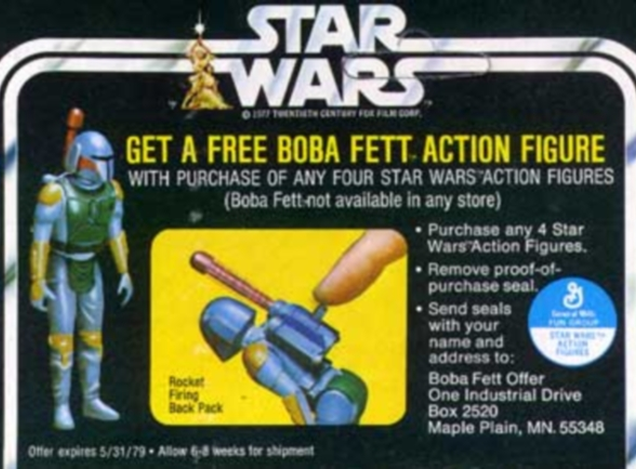
When the Star Wars line first hit in 1978, any damage that criticism of the Early Bird Certificate could have done was wiped out almost instantaneously. Joined by another eight figures, and with playsets and vehicles following later in the year, Kenner’s toyline was a smash success, making over $100 million in its first year alone — with demand often outstripping supply. Kenner’s toy line became the icon of the new era of 3.75” figures.
The following year, the company capitalised on the announcement of a sequel, The Empire Strikes Back, with another mail-away campaign: one that proved to be far more controversial than the Early Bird Cerificate.
In the new promotion, kids could mail four proofs of purchase from any Star Wars figure and get a sneak peek of a new Empire toy, the mysterious bounty hunter Boba Fett, who had made his first appearance the year prior in the infamously atrocious Star Wars Holiday Special. The figure came with a heavily advertised rocket-firing jetpack feature, but shortly before Boba Fett went to market, a rash of health-and-safety fears caused Kenner to make a late decision to glue the rocket into the backpack securely. Kenner has always maintained that they never released a rocket-firing Fett into the wild, but several such figures (as well as early production prototypes) have made their way into the hands of collectors over the years, making it one of the most valuable Star Wars toys ever made, selling for upwards of $2000 when one appears at auction.
By the release of Return of the Jedi, the line had expanded to contain 79 figures, with oodles of playsets, vehicles and creatures released. But without movies to support them, sales slowly began to dwindle. Kenner attempted to offset the decline with brief lines based on the animated Droids and Ewok cartoons, the first non-movie Star Wars toys ever made, but it was too late. In 1985, after 250 million Star Wars figures had been shipped over the world, Kenner ended the toyline. Plans were even made for a spinoff line the following year, The Epic Continues, featuring new characters based on a storyline created by Kenner in an attempt to reignite interest in the toys, but Lucasfilm rejected the move. For now, Star Wars as a toyline was over.
A New Hope
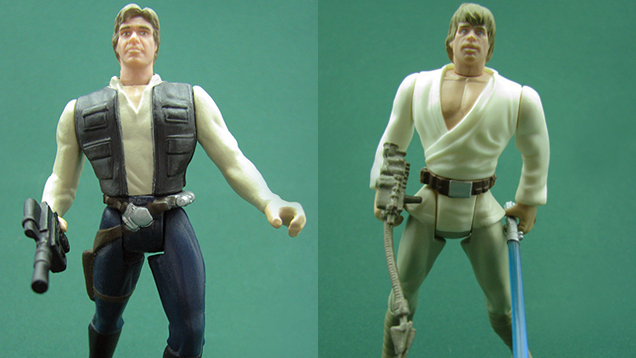
But it only took a decade for that to all change. By the mid 1990s, George Lucas had announced his intent to create three brand new Star Wars films, prequel movies to the originals, and specially remastered editions of the classic trilogy were being prepared to hit cinemas once again. Kenner, now owned by Hasbro, decided to capitalise on the excitement surrounding Star Wars by going back and creating new figures, a spiritual sequel to the Power of the Force Line that ended the original toyline in 1985.
The figures were a massive success, but collectors and fans of the original figures were appalled. The initial Hasbro/Kenner toys — published under the Kenner name rather than Hasbro to capitalise on nostalgia — only included one extra piece of articulation (they could turn at the waist), but more egregious was what Hasbro had dubbed the “Hero Age” sculpts. The initial figures were muscled up to the point where they were unrecognisable (even Princess Leia, whose figure was quickly dubbed “Monkey Leia” by fans for her awkward pose and poor face sculpt) and with a weirdly wide-legged stance that made it impossible to get the figures to properly sit in vehicles and ships.
But nevertheless, the new figures were immensely popular, spurred by the release of the Special Editions. Hasbro upped production on the Star Wars line once more, and even began incorporating elements of the then-fledgling Expanded Universe. Characters from the original Kenner line like Yak Face and Hammerhead were given their EU-sourced names (Saelt-Marae and Momaw Nadon, respectively), and for the first time, characters from the novels and video games were turned into toys, like Emperor’s Hand Mara Jade, or the bulky Dark Troopers from Star Wars: Dark Forces.
The Phantom Preview
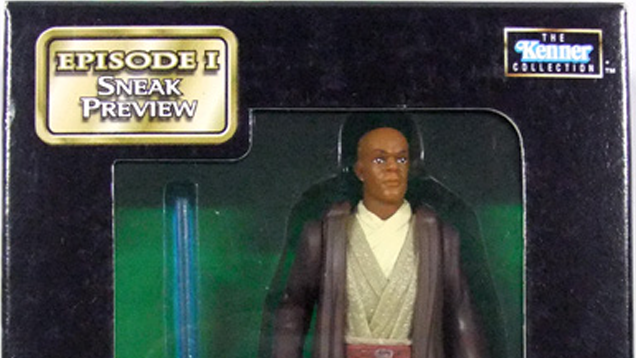
But Hasbro’s focus on the original movies soon gave way to the insane anticipation for The Phantom Menace. This time, they opted not to go for a mail-away campaign. Instead, in an unprecedented move, they sold two new toys in 1998 to stoke excitement for the film: a figure of Samuel L. Jackson’s Mace Windu (complete with a blue lightsaber, ahead of the character getting a purple saber in Attack of the Clones) and a deluxe figure of a Battle Droid on a STAP speeder bike. Both figures came in special packaging, teasing the release of The Phantom Menace in 1999, and gave fans some of the first proper looks at new characters. They were lapped up over the year, and excitement for Phantom Menace toys reached fever pitch.
Aside from a surge in popularity due to the new movie, Hasbro decided to tie the toy line closer to the films by ditching the “Hero Age” sculpts, opting for a neutral and more naturally-bodied stance. The Phantom Menace figures also came with a voice chip accessory that, when used with a separate toy based on Jedi Master Qui-Gonn Jinn’s communicator from the film, played lines of dialogue from the films.
Attack Of The Super-Articulated Clones
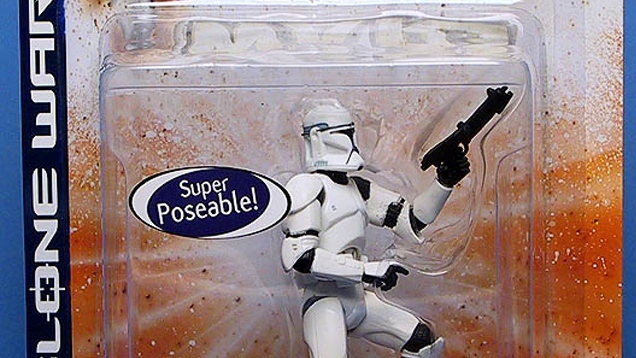
But despite the success of the new toy line, and an invigorated public interest in Star Wars merchandise thanks to new movies coming out, Hasbro faced pressure to evolve the toy line even further. A common critique was the figures’ lack of articulation, something that had hardly changed since the original Kenner days, compared to other figures on the market — something Hasbro decided to rectify with their Attack of the Clones line in 2002. The first ever “super articulated” Star Wars toy, a Clone Trooper, went on sale in 2004, and was so popular the figure continued to be a part of Star Wars lines for the next half a decade.
Hasbro brought the increased articulation to a wider range of figures for its Revenge of the Sith toy line in 2005. Although excitement over the prequel saga had diminished since the late ‘90s, Hasbro made a huge push with what it thought could be the final years of the Star Wars toy line. As with The Phantom Menace toys before them, sneak preview figures were released (General Grievous, Utapaun politician Tion Medon, a Wookiee warrior and the R4-G9 astromech droid), but Hasbro also pushed midnight releases of the product line across US toy stores, encouraging fans to queue up in costume and celebrate the release of the toys.
Black And Blue
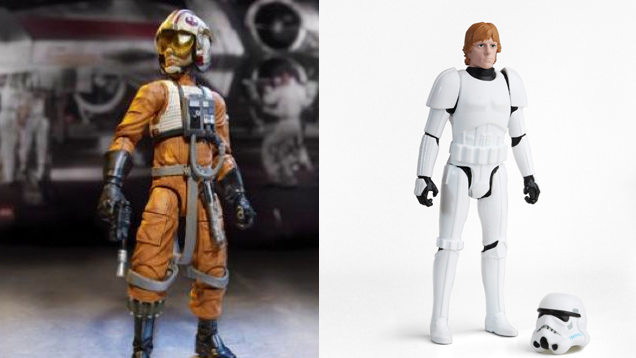
Despite the lack of a new movie to keep fans interested, the Star Wars toy line did not come to an end as Hasbro had feared. The success of the Revenge of the Sith toy line, mainly thanks to the improved sculpting and articulation it included, spurred Hasbro to go back to the previous films and make new figures that included the extra articulation and detail (they also added premium features like cloth clothing — earlier toys sculpted clothes out of plastic, and in the case of the first Kenner figures, vinyl sheets were used for cloaks and robes) they had previously lacked. The figure line would then be bolstered by the announcement of a new animated series, Star Wars: Clone Wars in 2008, but by and large Hasbro’s Star Wars line closed out the 2000s in relative normality.
However, times were changing in the toy industry. Action figure popularity was on the decline (in favour of an emphasis on construction toys, like Mega Bloks and Lego), and the rising price of oil had a severe impact on manufacturing costs. The heavily detailed and articulated figures that Star Wars had become known for were becoming too expensive to produce.
Instead of cancelling the line however, Hasbro made the decision to split it in two. For the first time in Star Wars toy history, figures would be produced in the 6” scale. Announced in 2013 and dubbed “The Black Series,” these figures would keep the high articulation and improved detailing and be aimed solely at the collectors market, with higher prices to match (prices doubling from the usual $10-12 to $20-25).
The Black Series, however, came at the cost of the long running 3.75” line. Now aimed solely at younger children instead of trying to balance between appealing to kids and diehard collectors, Hasbro decided to cut the super articulation and detailing introduced 8 years prior with Revenge of the Sith to keep costs down. Many fans bemoaned the end of an era, but with Hasbro’s Star Wars toys grossing nearly six billion dollars since 1995, there was plenty proof out there that there was still an audience for both kinds of toys.
The Merchandising Awakens
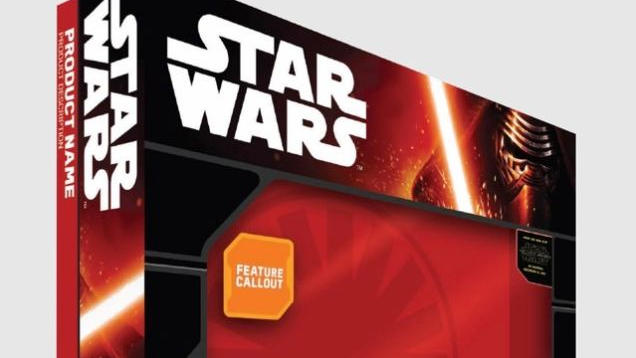
So where does that leave us in 2015? With a new era of Star Wars movie making upon us —following Disney’s acquisition of the Star Wars license and Episode VII on the way this December — toys will once again play an important role in how fans discover the new Star Wars universe. As it was with The Phantom Menace and Revenge of the Sith, the toys will be part of the earliest looks fans will see of the new movie (outside of teaser trailers, of course) when The Force Awakens merchandise is launched on September 4th, as part of a heavily marketed “Force Friday” celebration. Three months ahead of the film may sound unbelievable to most, but as we’ve seen in Star Wars’ own past, it’s rather restrained.
Even with nearly 40 years between the Early Bird Certificate and these new toys, the relationship between Star Wars and its action figures is stronger than ever.
via Gizmodo
The Groundbreaking History Of Star Wars Toys